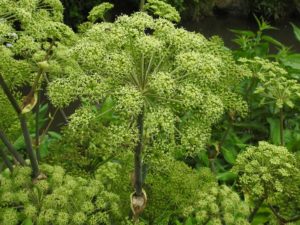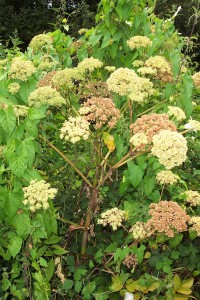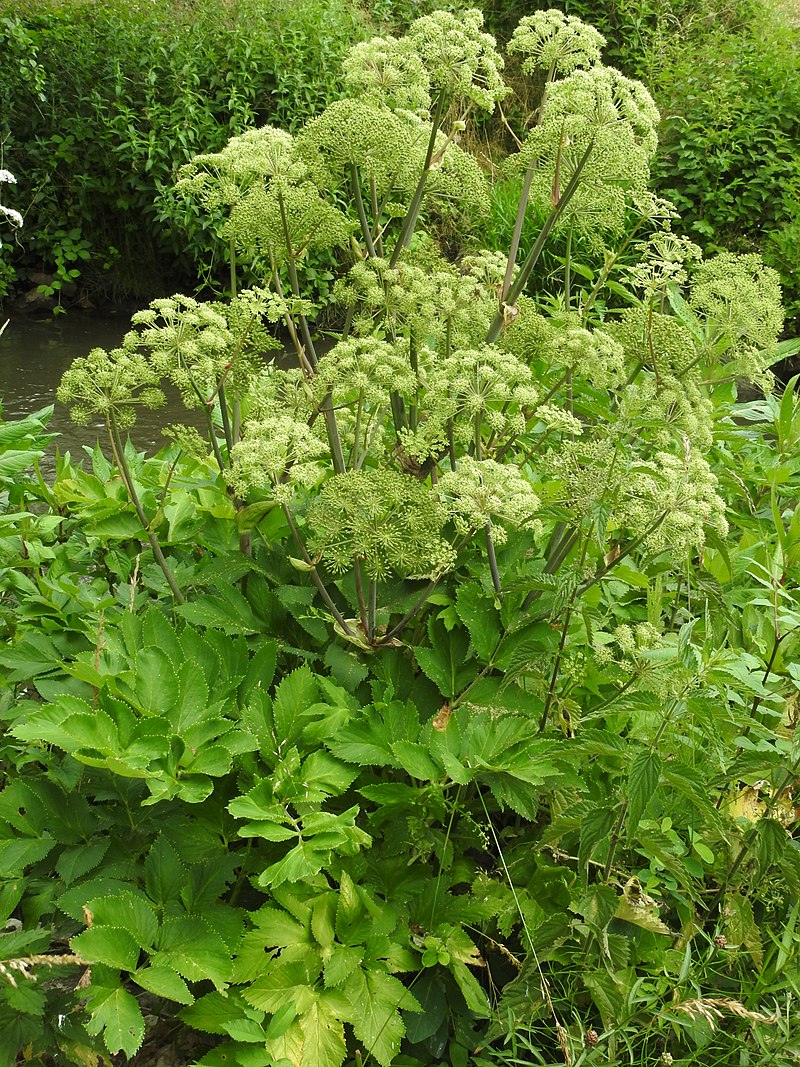
Angelica flowers are greenish white.
Angelica (Angelica archangelica) is a biennial herbaceous plant that is native to Scandinavia, Russia and Greenland. It is used medicinally by the shamans of the Sami people, formerly known as Laplanders. Angelica has been used both medicinally and as a vegetable for thousands of years. It should not be confused with Chinese angelica (A. sinensis), known as dang-gui, that is used in both Chinese and Ayurvedic medicines. Nor should it be confused with the American species, A. atropurpurea, which grows in swampy areas in the northeast of North American and was used by Native Americans to treat respiratory illnesses.
There are two stories explaining how angelica got its name. The best known story says that during the period that plague was ravaging Europe, an angel appeared in a dream to a monk and told him that the plant could cure the plague. The monk called the plant angelica in honor of the angel. Thanks to this dream, convent and monastery gardens always contained angelica during the Middle Ages because convents and monsteries were places of healing, the equivalent of our modern day hospitals. The other lesser known story says that the plant got its name because it blooms on May 8, the Feast Day of St. Michael the Archangel.
Modern herbalists use angelica as a menstrual regulator and as both an expectorant and a diuretic. Additionally it is used to treat kidney ailments, urinary infections, constipation and for ailments of the lungs. It is also used to treat fevers.
The roots have a similar taste and odor as juniper and have been used in the manufacture of gin. The roots are also used to flavor liqueurs such as Benedictine, Chartreuse, Dubonnet and Vermouth. In cooking they are used to flavor eggs, fish and jam. The stems have also been candied and used as decorations.
Angelica is hardy in zones 4 through 9 but it struggles in the hot summers of the south. It prefers partial shade, especially in the south, but will grow in full sun. The plants will grow much larger in partial shade. Unlike a lot of herbs, it likes moist soil and is often found growing near rivers and marshes.

First year rosette of leaves.
The first year, a rosette of leaves grows. The leaves can be as long as 40”. If you are using the leaves, you can lightly harvest leaves the first year. You must be careful not to remove too many. The root needs the leaves to photosynthesize food so that it can grow the second year. The leaves die completely in the fall of the first year.
The second year, leaves and a stem grow. This is the year that you can harvest more leaves since this is the last year that the root will survive. The stem is bright green and resembles celery resulting in the nickname Wild Celery. The stems can reach a height of 7 feet, shorter in full sun. The flowers grow in umbels that are 10 inches in circumference at the tops of the stems. The buds are burgundy but open to flowers that are greenish white. Bloomtime is July. The flowers mature into green fruits that turn brown when mature.

The fruit ripens to brown.
Most gardeners buy angelica from nurseries as first year plants but it is possible to grow it from seed. You can direct sow the seed in your garden in the fall for germination in the spring. Surface sow them. Do not cover the seeds. They need light to germinate.
If you want to start your seeds indoors, they will need to be cold stratified. Unlike most seeds that you can just put in your refrigerator for a period of time, angelica seeds need alternating periods of cold and warm temperatures. 6 to 8 weeks before your last frost, surface sow the seeds in containers (do not cover them, they need light to germinate) and keep the containers in your refrigerator at night then bring it out to a warm room during the day. Do this for for 21 days and nights. After three weeks, leave the containers in a sunny warm room day and night. Germination should occur in 10 days. You can transplant your seedlings outdoors after your last frost when they have reached a height of 3 to 4 inches. Plant them at least 12 inches apart.

